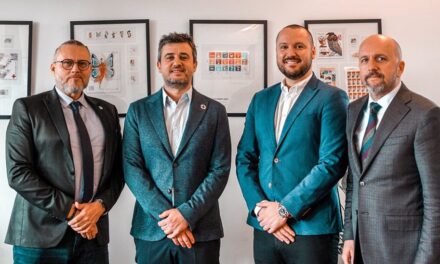
A digital partnership transformed postal service provider into Nordic front-runner

In 2002, state-owned Post Danmark stood at a crossroads: The corporation had to choose either solely to focus on the physical logistics of letters and parcels or to stake its future on building strong digital competences. Post Danmark chose the latter and set off on a journey to become a digital leader in the Nordic region. Post Danmark also started a lasting partnership with e-Boks.
The journey towards digitalisation
In Denmark, the volume of physical letters peaked around the year 2001. The internet and e-mail spread throughout the 1990s, and growing digitalisation among companies, public authorities, and private customers gave rise to heavy considerations in the leadership of the state-owned postal services provider on the threshold of the new millennium.
“We predicted that digitalisation would gradually decrease the letter volume in Denmark. Our Board found itself at a strategic watershed. It had to decide whether to join the digital wave or dive headlong into the physical part of our business,” recalls Business Development Manager, Giovanni Belli.
The Board decided that Post Danmark should offer digital postal services and invested in a partnership with e-Boks, in which Post Danmark was both distributor and co-owner. In the role of distributor, the company has since provided e-Boks solutions for secure mail distribution, signature, and payment services to a large number of customers.
Synergies between digital and physical post
Giovanni Belli has been responsible for business development at PostNord Strålfors since summer 2019. All the group’s digital communication solutions are gathered in the PostNord Strålfors unit. He has worked at the group for a total of 19 years. Therefore, he experienced at first hand the merger of Post Danmark and Swedish Posten AB in 2009 to become PostNord.
He clearly remembers the early days of the partnership with e-Boks. At the time, he recalls, PostNord thoroughly investigated the prospect of developing an independent digital postbox solution.
“Within the company, we seriously considered developing our own technology. Based on our desire to combine the business case with stronger business focus, we eventually decided to invest in a partnership with e-Boks. Essentially, we preferred to be a stronger partner for our customers than to develop our own product,” explains Giovanni Belli.
Especially with regards to the customer, he sees no real contradiction in the classic postal distributor’s running a modern digital communication services business.
“While you might think that physical and digital post are two very different things, there are obvious synergies between the two. We seek to offer the services our customers need, and they are usually looking for a mix of digital communication and letter post. This is not simply a matter of catering for a residual group of the population that has not gone digital. The letter remains important for our business customers. Having close ties with the physical postal business is certainly an asset.”
Ambition and innovation
It turns out that going digital was a wise and important decision for the postal services group. Shortly after 2002, the volume of letters began to decline steadily, initially with small declines of a few percent per year, later with significant double-digit declines up through the 2010s.
In recent years, PostNord has fine-tuned its focus in the various areas of its business. Across the Nordic region, the postal companies focus 100 % on logistics, parcels, and letters. Meanwhile, the group’s digital investments are concentrated at PostNord Strålfors that has become a leading international provider of digital solutions.
“PostNord Strålfors is a company with 100 years of experience that currently focuses 100 % on digital solutions. PostNord regards the unit as an investment in innovation. We have more room to manoeuvre and stronger focus than the rest of the organisation. We have had greater freedom to develop,” explains Giovanni Belli.
Today, PostNord Strålfors provides its customers with Omnichannel solutions for communications via mobile phone, text messages, and EDI transactions. However, e-Boks and digital post continue to play a decisive role in contact between companies and citizens, especially in Denmark. Moreover, deliveries of all kinds are increasingly intertwined with strong insight into the customer’s processes. In digitalisation cases, costs are invariably a key factor, but it is also very important that PostNord Strålfors helps the customer to resolve his challenges and optimise his business, for example, by simplifying work processes in connection with invoice payment or document signature. This is precisely where e-Boks’ solutions come into play.
European leader
When it comes to digital post, Denmark is one of the leading countries in the world. We have had the digital postbox, e-Boks, for more than 20 years. It makes perfect sense to ask Belli if he has a word of advice for the postal services in other countries, which have yet to leap into the digital era. He advises them first and foremost to seek partnerships and then to allow themselves to be driven by the market:
“I believe you need to base your strategy solidly on the solutions you wish to provide for your customers. Technological development must always be based on what your customers believe creates value – and what you can sell. You also have to decide how much you wish to develop yourself. Our strategy was to join up with partners, such as e-Boks, that had an efficient digital postbox – as this allowed us to maintain focus on the customer,” he explains.
Balance between senders and recipients
Visionary politicians and authorities more than willing to promote a widespread public digital postbox via e-Boks got the digitalisation of Danish society off the ground. For other countries that need to start from scratch with a new postal solution, the challenge will often be to achieve a balance between private senders and recipients. Both parties must see the benefits of joining the system.
“A platform is nothing without its users. This said, you must recruit an initial 10-15 sender companies before you can attract users to your platform. In Denmark, e-Boks succeeded in recruiting Danske Bank as one of its first major senders, and I believe that the first private senders were decisive. Without them, e-Boks’ recipient penetration would not have become so deep,” Giovanni Belli surmises. He goes on to add:
“We often credit a government digitalisation strategy and the introduction of mandatory digital post from public authorities for the achievement of widespread acceptance of digital post in Denmark. In fact, e-Boks had such broad coverage among the private senders that it would have continued to spread even without public intervention.”
A leading operator must be pro-active
Giovanni Belli postulates that, in essence, many of today’s international postal service providers face the same choices as Post Danmark almost 20 years ago.
“If you look around Europe, there is a huge diversity of postal service providers. Some have strong financial focus; others lean more heavily towards delivering conventional logistics. If you wish to become a leading distributor in the future, you must be pro-active and develop,” he says and adds:
“The volume of physical post in Denmark today is 80 % less than at its peak. And digital volume has increased accordingly. If PostNord had not gone digital back then, our business would have been much smaller today.”
With Europe surging through its technological revolution, the European Commission further sees digital transformation as the bridge between a greener future and a digital society. To support this progress, it developed the Digital Europe Programme, allocating €7.5 billion to accelerate digital transformation and sustain independence in digital services.











